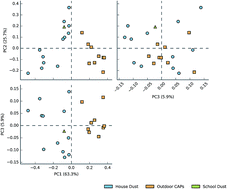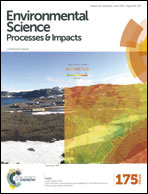Characterization of the bacterial and fungal microbiome in indoor dust and outdoor air samples: a pilot study†
Abstract
Environmental microbes have been associated with both protective and adverse health effects in children and adults. Epidemiological studies often rely on broad biomarkers of microbial exposure (i.e. endotoxin, 1 → 3-beta-D-glucan), but fail to identify the taxonomic composition of the microbial community. Our aim was to characterize the bacterial and fungal microbiome in different types of environmental samples collected in studies of human health effects. We determined the composition of microbial communities present in home, school and outdoor air samples by amplifying and sequencing regions of rRNA genes from bacteria (16S) and fungi (18S and ITS). Samples for this pilot study included indoor settled dust (from both a Boston area birth cohort study on Home Allergens and Asthma (HAA) (n = 12) and a study of school exposures and asthma symptoms (SICAS) (n = 1)), as well as fine and coarse concentrated outdoor ambient particulate (CAP) samples (n = 9). Sequencing of amplified 16S, 18S, and ITS regions was performed on the Roche-454 Life Sciences Titanium pyrosequencing platform. Indoor dust samples were dominated by Gram-positive bacteria (Firmicutes and Actinobacteria); the most abundant bacterial genera were those related to human flora (Streptococcus, Staphylococcus, Corynebacterium and Lactobacillus). Outdoor CAPs were dominated by Gram-negative Proteobacteria from water and soil sources, in particular the genera Acidovorax, and Brevundimonas (which were present at very low levels or entirely absent in indoor dust). Phylum-level fungal distributions identified by 18S or ITS regions showed very similar findings: a predominance of Ascomycota in indoor dust and Basidiomycota in outdoor CAPs. ITS sequencing of fungal genera in indoor dust showed significant proportions of Aureobasidium and Leptosphaerulina along with some contribution from Cryptococcus, Epicoccum, Aspergillus and the human commensal Malassezia. ITS sequencing detected more than 70 fungal genera in indoor dust not observed by culture. Microbiome sequencing is feasible for different types of archived environmental samples (indoor dust, and low biomass air particulate samples), and offers the potential to study how whole communities of microbes (including unculturable taxa) influence human health.


 Please wait while we load your content...
Please wait while we load your content...